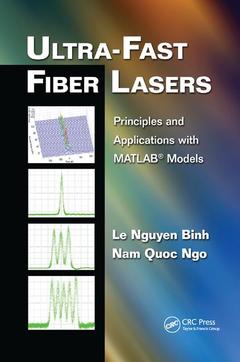Ultra-Fast Fiber Lasers Principles and Applications with MATLAB® Models Optics and Photonics Series
Auteurs : Binh Le Nguyen, Quoc Ngo Nam

Ultrashort pulses in mode-locked lasers are receiving focused attention from researchers looking to apply them in a variety of fields, from optical clock technology to measurements of the fundamental constants of nature and ultrahigh-speed optical communications. Ultrashort pulses are especially important for the next generation of ultrahigh-speed optical systems and networks operating at 100 Gbps per carrier.
Ultra Fast Fiber Lasers: Principles and Applications with MATLAB® Models is a self-contained reference for engineers and others in the fields of applied photonics and optical communications. Covering both fundamentals and advanced research, this book includes both theoretical and experimental results. MATLAB files are included to provide a basic grounding in the simulation of the generation of short pulses and the propagation or circulation around nonlinear fiber rings. With its unique and extensive content, this volume?
- Covers fundamental principles involved in the generation of ultrashort pulses employing fiber ring lasers, particularly those that incorporate active optical modulators of amplitude or phase types
- Presents experimental techniques for the generation, detection, and characterization of ultrashort pulse sequences derived from several current schemes
- Describes the multiplication of ultrashort pulse sequences using the Talbot diffraction effects in the time domain via the use of highly dispersive media
- Discusses developments of multiple short pulses in the form of solitons binding together by phase states
- Elucidates the generation of short pulse sequences and multiple wavelength channels from a single fiber laser
The most practical short pulse sources are always found in the form of guided wave photonic structures. This minimizes problems with alignment and eases coupling into fiber transmission systems. In meeting these requirements, fiber ring lasers operating in active mode serve well as suitable ultrashort pulse sources. It is only a matter of time before scientists building on this research develop the practical and easy-to-use applications that will make ultrahigh-speed optical systems universally available.
Introduction. Principles and Analyzes of Mode-Locked Fiber Lasers. Active Mode-Locked Fiber Ring Lasers: Implementation. NLSE Numerical Simulation of Active Mode-Locked Lasers: Time Domain Analysis. Dispersion and Nonlinearity Effects in Active Mode-Locked Fiber Lasers. Actively Mode-Locked Fiber Lasers with Birefringent Cavity. Ultrafast Fiber Ring Lasers by Temporal Imaging. Tera-Hertz Repetition Rate Fiber Ring Laser. Nonlinear Fiber Ring Lasers. Bound Solitons by Active Phase Modulation Mode-Locked Fiber Ring Lasers. Actively Mode-Locked Multiwavelength Erbium-Doped Fiber Lasers. Appendices. Index.
Le Nguyen Binh received his BE (Hons) and Ph.D degrees in electronic engineering and integrated photonics in 1975 and 1980, respectively, from the University of Western Australia, Nedlands, Western Australia. In 1980, he joined the Department of Electrical Engineering at Monash University, Clayton, Victoria, Australia, after a three-year period with Commonwealth Scientific and Industrial Research Organisation (CSIRO), Camberra, Australia, as a research scientist. In 1995, he was appointed as reader at Monash University. He has worked in the Department of Optical Communications of Siemens AG Central Research Laboratories in Munich, Germany, and in the Advanced Technology Centre of Nortel Networks at Harlow, United Kingdom. He has also served as a visiting professor of the Faculty of Engineering of Christian Albrechts University of Kiel, Germany. Dr. Binh has published more than 250 papers in leading journals and refereed conferences, and three books in the field of photonic signal processing and optical communications: the first is Photonic Signal Processing, the second is Digital Optical Communications and the third on Optical Fiber Communications Systems (both published by CRC Press, Boca Raton, Florida). His current research interests are in advanced modulation formats for long haul optical transmission, electronic equalization techniques for optical transmission systems, ultrashort pulse lasers, and photonic signal processing.
Nam Quoc Ngo received his BE and PhD degrees in electrical and computer systems engineering from Monash University, Melbourne, Victoria, Australia, in 1992 and 1998, respectively. From July 1997 to July 2000, he was a lecturer at Griffith University, Brisbane, Queensland, Australia. Since July 2000, he has been with the School of Electrical and Electronic Engineering (EEE), Nanyang Technological University, Singapore, where he is presently an associate professor. Since March 2009, he has been the
Date de parution : 09-2018
15.6x23.4 cm
Date de parution : 07-2010
Ouvrage de 419 p.
15.6x23.4 cm
Thèmes d’Ultra-Fast Fiber Lasers :
Mots-clés :
Mode Locking; Principles and Analysis of Mode-Locked Fiber Lasers; Te Ns Ity; Active Mode-Locked Fiber Ring Lasers: Implementation; Pulse Train; Dispersion and Nonlinearity Effects in Active Mode-Locked Fiber Lasers; Ring Laser; Ultrafast Fiber Ring Lasers by Temporal Imaging; Locking Range; Nonlinear Fiber Ring Lasers; Actively Mode Locked; Passive Mode Locking; Soliton Pulse; Optical Spectrum Analyzer; Fundamental Frequency; Frequency Detuning; Harmonic Mode Locking; Cavity Dispersion; Optical Pulse Train; SPM Effect; Mode Locked Fiber Lasers; Steady State Pulse; Mode Locked Pulse Train; WDM Coupler; Output Pulse Train; FWM Effect; XPM Effects; Soliton State; Phase Modulation Index; Phase Plane Analysis



